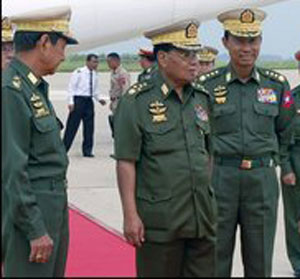The Burmese military is intensifying the pressure on two armed ethnic groups in the northeast, by sending more troops to the militarily strategic Kokang territory, according to local eyewitnesses.
Hundreds of fresh Burmese troops were transported to the frontlines east of the Salween River, by crossing the Thapa Bridge.Area residents said the area was captured in August, 2009, from the Peng Jiasheng-led Kokang rebels, also called the Myanmar National Democratic Alliance Army (MNDAA).
A local eyewitness told the Kachin News Group today, the Burmese troops, from the Meiktila-based Light Infantry Division (LID) 99, were transported to the captured area in more than 30 military trucks, on January 8th.
No Burmese soldiers, already deployed in the territory, withdrew after the arrival of the reinforcements, according to local people.
A villager said, “Just 20 trucks went back empty. It might be the buildup to war with the Kachin and Wa”.
Local military analysts said the latest troop buildup is aimed at cutting access and communication between the 4th brigade of the Kachin Independence Army (KIA), located west of the Salween River and the United Wa State Army (UWSA), east of Kokang.
They rejected the junta’s plans to disarm them and transform their armed-wings into a border guard force, under the control of the Burmese Army.
The Kokang territory is strategic militarily, because it connects the areas occupied by the Kachin and Wa.

A high ranking officer in the KIA’s 4th brigade headquarters, in Loikang, told KNG today, “I think the deployment of fresh reinforcements by the Burmese Army is related to the announcement by exiled Kokang leader Peng Jiasheng about two months ago, who said he will celebrate Chinese New Year this month in Laogai (also spelled Laukai), his fallen capital”.
On August 24, 2009, the Burmese Army broke the ceasefire agreement in the Kokang area, when they captured the rebel’s capital, Laogai.
Over 35,000 Kokang Chinese refugees fled to the Chinese border town Nansan.
Since last April, the Burmese military has had regular meetings with the Kachin. On January 29th, Kachin and Burmese military officials met for the 10th time, to negotiate transforming the KIA into the junta-proposed border guard force, as well as other issues.
But, they have not met regularly with the Wa, who are the strongest ethnic armed group.
Since early January, more Burmese troops have been deployed around the Wa territories.
However, there are no fresh military reinforcements near Kachin held areas in both Kachin State and Northeast Shan State, according to KIA officers.



